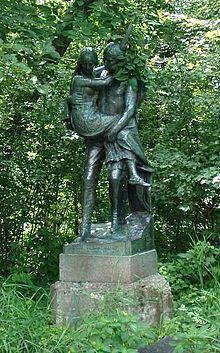
Back The Song of Hiawatha BAR Песен за Хайауата Bulgarian Píseň o Hiawathovi Czech Das Lied von Hiawatha German The Song of Hiawatha Esperanto Laul Haiavatast Estonian Laulu Hiawathasta Finnish Le Chant de Hiawatha French De Sang fan Hiawatha Frisian Հայավաթի երգը Armenian

The Song of Hiawatha is an 1855 epic poem in trochaic tetrameter by Henry Wadsworth Longfellow which features Native American characters. The epic relates the fictional adventures of an Ojibwe warrior named Hiawatha and the tragedy of his love for Minnehaha, a Dakota woman. Events in the story are set in the Pictured Rocks area of Michigan on the south shore of Lake Superior. Longfellow's poem is based on oral traditions surrounding the figure of Manabozho, but it also contains his own innovations.
Longfellow drew some of his material from his friendship with Ojibwe chief Kahge-ga-gah-bowh (George Copway), who would visit Longfellow's home. He also had frequent encounters with Black Hawk and other Sauk people on Boston Common, and he drew from Algic Researches (1839) and other writings by Henry Rowe Schoolcraft, an ethnographer and United States Indian agent, and from Heckewelder's Narratives.[1] In sentiment, scope, overall conception, and many particulars, Longfellow insisted, "I can give chapter and verse for these legends. Their chief value is that they are Indian legends."[2]
Longfellow had originally planned on following Schoolcraft in calling his hero Manabozho, the name in use at the time among the Ojibwe of the south shore of Lake Superior for a figure of their folklore who was a trickster and transformer. But he wrote in his journal entry for June 28, 1854: "Work at 'Manabozho;' or, as I think I shall call it, 'Hiawatha'—that being another name for the same personage."[3] Longfellow was following Schoolcraft, but he was mistaken in thinking that the names were synonymous. The name Hiawatha is derived from a pre-colonial figure associated with the League of the Iroquois, then located in New York and Pennsylvania.[4] The popularity of Longfellow's poem nevertheless led to the name "Hiawatha" becoming associated with a number of locales and enterprises in the Great Lakes region.[5]
- ^ Longfellow, Henry (1898). The Song of Hiawatha. New York: Hurst and Company. p. v.
- ^ Williams 1991, p. 316.
- ^ Williams 1991, p. 314.
- ^ Thompson 1922, p. 129.
- ^ Singer 1988.